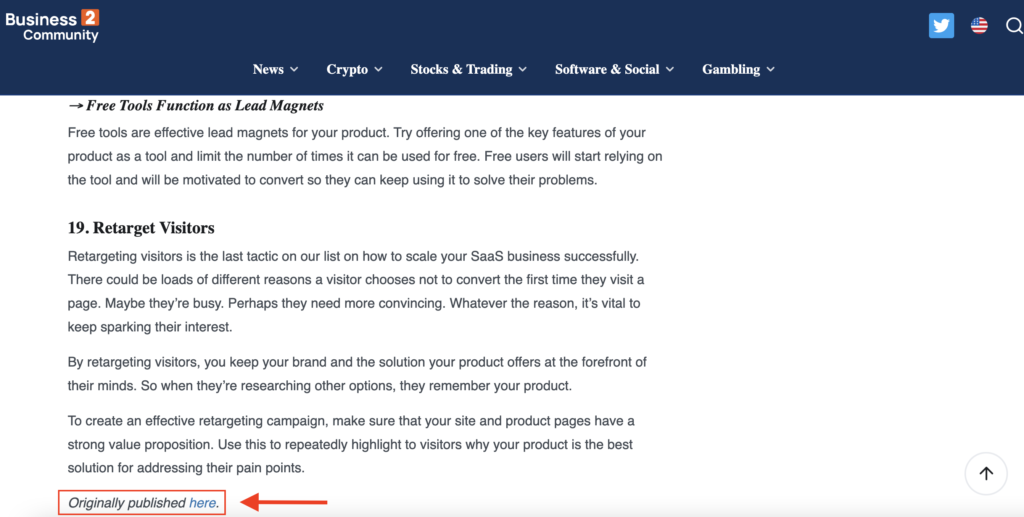Getting noticed online can feel like running on a treadmill. You’re putting forth plenty of effort, but don’t move anywhere. While online visibility through well-known strategies like SEO is possible, it often takes time and considerable effort. If you’re looking for more reliable and faster results, consider adding B2B content syndication to your toolset.
B2B content syndication reaches more of your target audience online than SEO alone while facing less competition. Additionally, content syndication works exceptionally well for account-based marketing strategies with a niche audience and target accounts list.
Are you new to B2B content syndication?
Use this quick guide to learn what it is and how to use it in B2B marketing to reach your target audience.

What Is B2B Content Syndication?
A content syndication meaning in simple terms is distributing your digital content on multiple third-party sites to increase visibility and generate leads.
How does this look?
If you want to syndicate or share your content, you work with a vendor. A vendor has a network of hundreds of third-party websites ready to publish your content.
You use filters to specify location, titles, business sizes, and other qualifying factors of the audience you want to reach with your content. That way, only third-party websites that reach your niche audience will publish the content, and you only receive relevant leads in return.
Your vendor distributes your content by sharing it across their network based on your selected filters. Your content then appears on several websites that your audience already frequents.
Content syndication differs from guest posting because you share the same content you published elsewhere. Guest posting uses original content. Even though content syndication copies published content, it won’t impact your SEO. Google prioritizes original content. Your syndicated content mainly targets current readers on the host sites rather than trying to rank in Google.

Image from S2W Media
Example of Content Syndication
Syndicated content appears in several ways:
- Native ad: A customized link to your content appears in the sidebar or bottom of third-party websites with related content. It’s often a widget that updates regularly with new content.
- Published content: Content appears alongside the site’s regular content but with a note like “Originally appears on…” or “Sponsored Content.” This content remains permanently on the site.

Image from Business2Community
What Types of Content Can You Syndicate?
You can syndicate any online content. Some of the most effective content includes:
- Blog posts
- Videos
- Infographics
- Podcasts
- Whitepapers
- Case Studies
If you’re looking to generate leads, consider using whitepapers or eBooks that you can gate rather than blog posts.
Why Is B2B Content Syndication Important?
There are over six million new blog posts every day published globally. Competing with that large amount of content requires an established website and authority in the industry. However, some topics are so competitive even authority sites struggle to appear near the top of search results.
Content syndication cuts through the noise and boosts site traffic. Through content syndication, you attract new visitors, which can increase your current ranking and authority. In addition, you gain some of the host website’s authority, increasing readers’ trust when engaging with your content. You also reach readers you might not have gotten through SEO strategies alone.
B2B content syndication allows marketers to target their audience. While SEO provides some customization, most traffic is left to chance. You hope that those searching your keywords are B2B buyers. However, content syndication allows you to post your content on sites your niche audience frequents, increasing your chance of reaching that audience.
How Content Syndication Complements Account-Based Marketing
Content syndication works well for B2B businesses using account-based marketing because it gives you more control over who you reach with your content. Through content syndication, you bring your content to your desired audience.
For example, a SaaS brand might share its content across leading SaaS websites where B2B buyers frequently find the latest news and tips. This puts marketers in direct content with those B2B buyers without relying on unpredictable SEO strategies.
6 Tips to Perform B2B Content Syndication
Use these six tips to get started with B2B content syndication.
1. Establish Your Content Syndication Goals
What do you hope to accomplish through content syndication? Establishing specific, measurable, achievable, realistic, and time-sensitive goals gives you benchmarks to aim for. That way, you know when your content syndication is successful.
Some examples of potential content syndication goals include:
- Increasing brand awareness by tracking the number of visitors who click on the content.
- Generating leads that fit your target audience.
- Collecting valuable customer data to help with customized marketing strategies.
2. Create a Target Accounts List
Creating your target accounts list begins with understanding who your ideal customer is. You create your ideal customer profile by compiling customer details from past customers and the characteristics of the customers you want to reach, like the buyer’s title or company size.
You’ll use this profile to identify target B2B buyers and businesses that make ideal customers. This list can include current customers, leads, and accounts that haven’t expressed interest.
Creating a target account list ensures you’re attracting quality leads. A target account list gives your content and strategy a direction based on who you’re trying to reach rather than casting a wide net and bringing in thousands of irrelevant leads.

Image from Sales Playbook
3. Partner with a B2B Content Syndication Vendor
A content syndication vendor is the company that distributes your content, like Taboola and Outbrain. If you don’t want to use a vendor, you can syndicate your content manually by posting to sites like Medium or LinkedIn. However, this process takes considerable work, research, and effort. You’re also limited by the host sites in your network.
Syndication vendors have a broader network of host sites and offer extensive filters so you can send your content to dozens of sites simultaneously for maximum reach.
4. Select or Create Relevant Content
Now comes the question of what content you should use.
Naturally, you’ll want to consider your syndication goal first, then choose content that matches that goal. For example, if you want to generate leads, then you’ll use whitepapers or eBooks.
You should also consider your content’s performance. For best results, syndicate your top-performing content as you know it’s relevant and your customers engage with it.
However, you don’t need to use content you’ve already published. Some marketers opt to create content specifically for syndication. That way, you can ensure the content matches your goals and audience.
5. Capture Lead Information
According to 30% of B2B marketers, content syndication has the best lead generation success.
Add value to your traffic by turning your content into a lead magnet. Gatekeeping your content or adding a form within the content provides more information about who is engaging with your content. You can also receive the details you need to qualify and nurture those leads.
When performing account-based marketing, a lead capture form is necessary to continue nurturing your audience.
6. Analyze Syndication Results
Remember those goals you established before starting? Now it’s time to revisit them and see how your results measure up.
A key to effective goals is establishing metrics for measuring your success, whether you generate a set number of leads or traffic you want to attract. Then, after syndicating your content, watch those metrics to gauge whether your syndication efforts are successful.
You’ll also want to dive deeper into those metrics, like seeing what percentage of the leads you generated converted. If not many leads are converting, you may need to adjust your target audience or reevaluate what content you’re using to ensure usable results.
Start Your First Content Syndication Strategy
Are you ready to start capturing quality leads across more channels?
Hushly can help you reach your ideal customer through our customized experience solutions. Our native embedded streams allow you to insert dynamic content that shows personalized suggestions to readers to increase the quality of leads you collect.
We simplify capturing those leads so you can seamlessly start nurturing them and converting more leads into loyal B2B buyers.
Learn more about our demand capture services for B2B content syndication.




